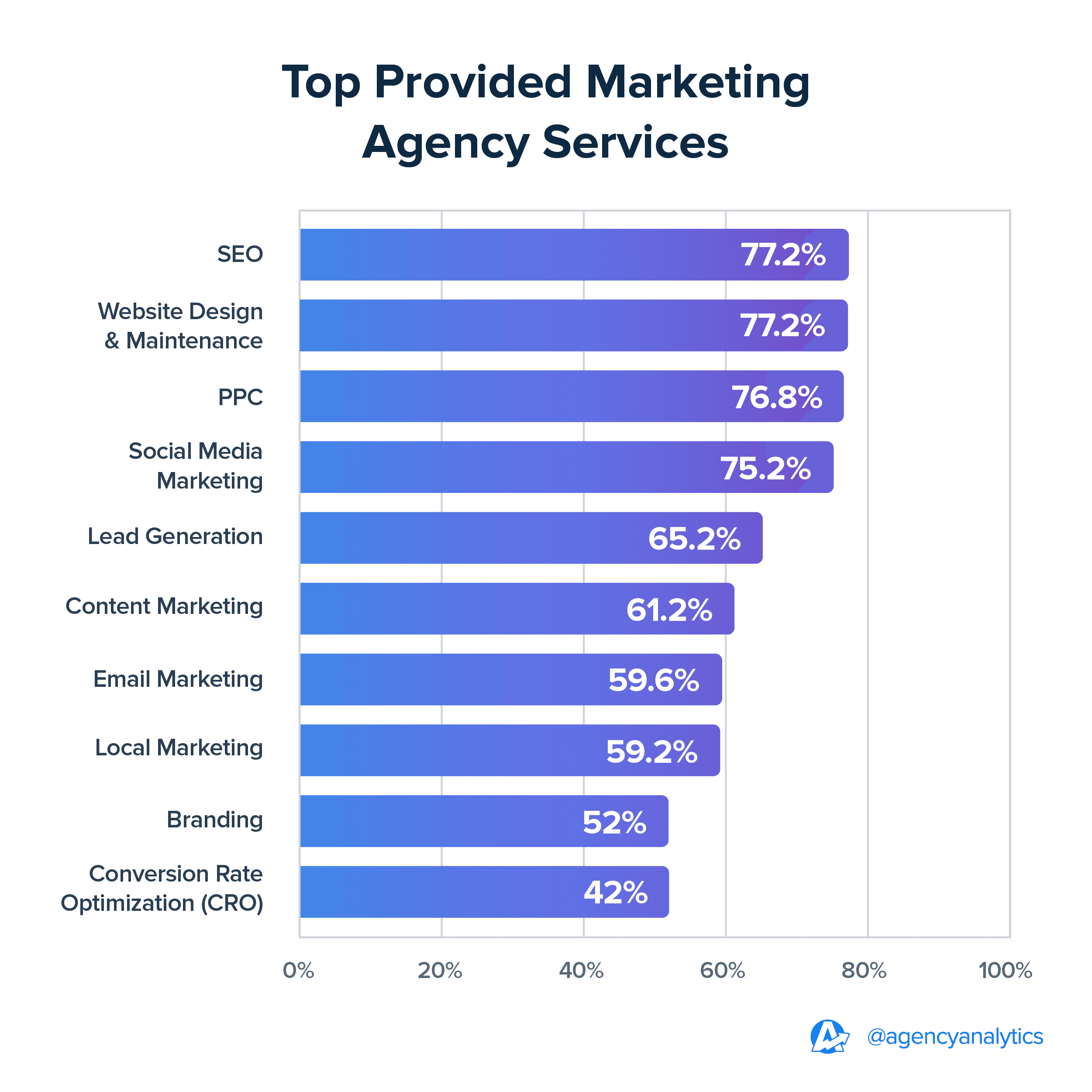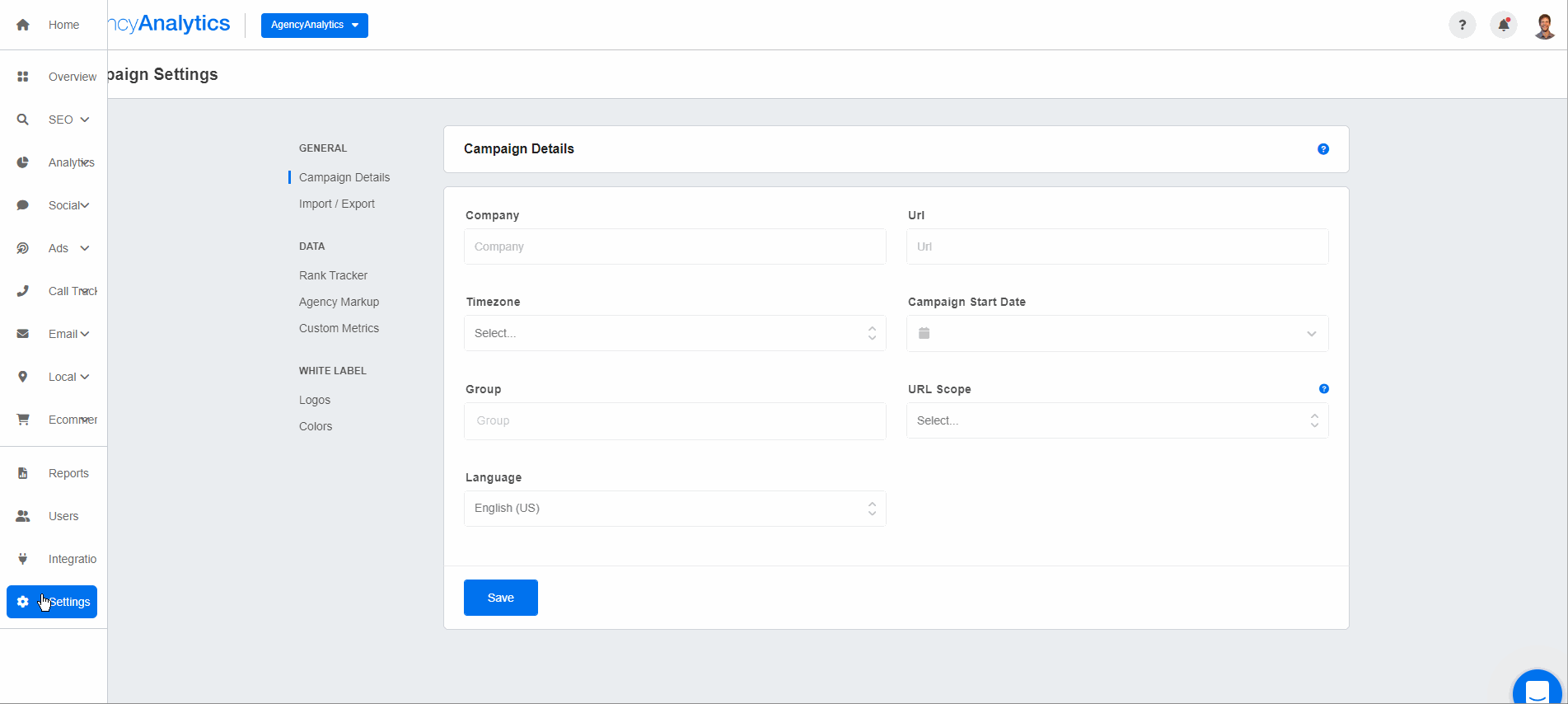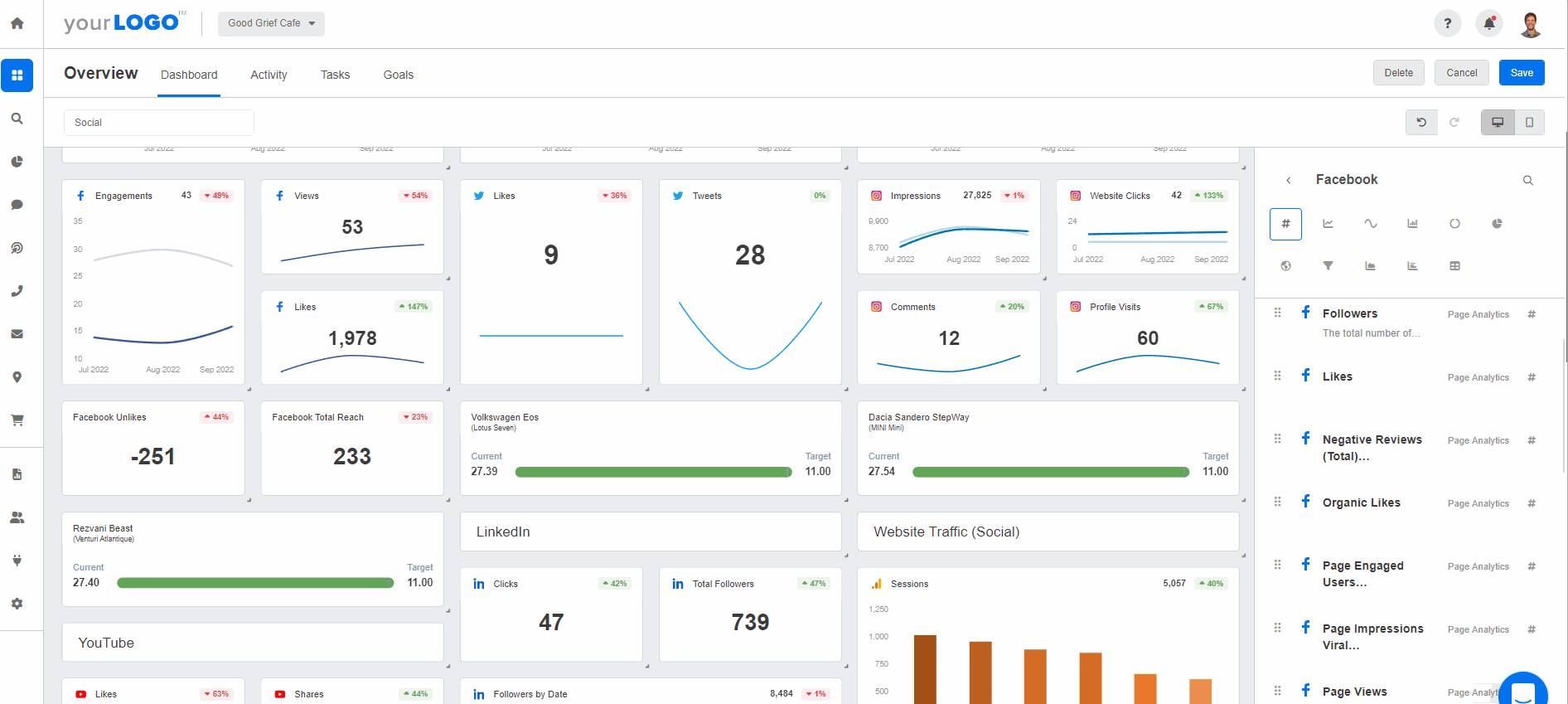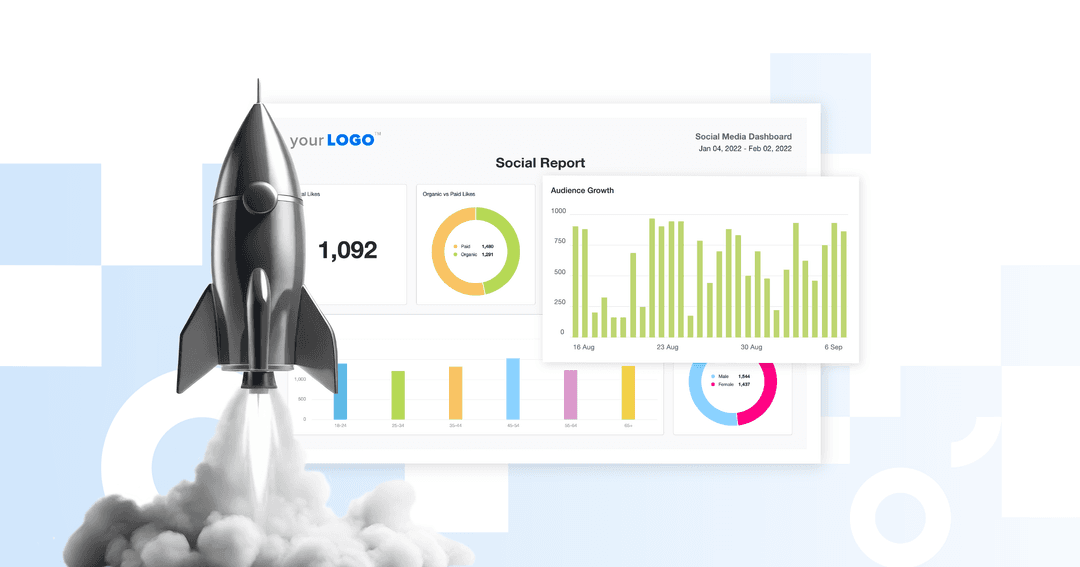Table of Contents
Table of Contents
- The Rising Complexity of Social Media Marketing Pricing for Agencies
- How Much Do Social Media Services Cost To Deliver?
- 6 Traditional Social Media Agency Pricing Models
- Pricing Your Agency’s Social Media Management by Service Type
- Just Starting Out? Here’s How Much To Charge for Freelance Social Media Management
- Answering the Client Question: “How Much Does Social Media Marketing Cost?”
7,000+ agencies have ditched manual reports. You can too.
Free 14-Day TrialQUICK SUMMARY:
Regularly reviewing social media pricing is critical–it ensures your agency is adequately compensated for expertise, effort, and time. Even so, pricing social media management packages isn’t always straightforward. To bridge this gap, this article explores effective pricing models, advice for maintaining profit margins, and how to decide on costs for commonly requested social media services.
Social media is always evolving.
From algorithm updates to new advertising regulations, every change creates a ripple effect on key parts of your business, like resource allocation and internal processes.
It’s just one of the reasons why a regular social media pricing review is so important; it should align with your agency’s invested time, effort, and expertise. Otherwise, what’s the point? That said, deciding on the right price isn’t always an easy or intuitive exercise. It’s a balancing act, after all–finding that sweet pricing spot that appeals to the market while ensuring it actually results in a profit for your agency.
While it may seem like a hassle, sticking to outdated pricing has consequences, such as reduced profit margins or less capital to reinvest in the business. Sounds like a lot to think about? Not to worry! Even the most seasoned social media management agency revisits pricing at some point, and it doesn’t have to be a guessing game.
In this article, we’ll explore appropriate pricing models, how to charge for frequently requested social media services, and relevant examples for more context.
The Rising Complexity of Social Media Marketing Pricing for Agencies
It’s no secret that social media marketing is in high demand.
In fact, social media ad spend is projected to reach $230 billion by 2025 (according to Statista), making it one of the most lucrative services out there. It aligns with the findings of our last Benchmarks Survey, too–social media marketing is among the top-requested services (offered by 75% of agencies that responded).

That said, a set-it-and-forget approach simply won’t work when deciding on social media pricing. Consider that:
Social Media Is Constantly Evolving: Whether it’s a platform change (e.g., the introduction of Facebook ODAX) or privacy updates, agencies must continuously adapt their approaches. And when more time and resources are involved, it should be reflected in end pricing.
Client Goals and Expectations Vary: Some clients may prioritize engagement growth, while others focus on direct social media ROI. This difference in needs requires pricing models that align with those unique campaign objectives.
Costs of Delivery Are Increasing: Salaries for skilled talent, subscriptions for analytics tools, and ad spend budgets are all rising. Therefore, your agency must consider these incurred costs to remain profitable.
Clients Have Many Options To Choose From: There’s no shortage of service providers on the market. Clients will often compare rates across agencies (or even freelancers), searching for the most bang for their buck. To remain competitive, your agency’s social media pricing should factor in the wider landscape.
By accounting for these dynamics, agencies will be better equipped to build a solid pricing strategy–one that’s competitive, meets client needs, and ensures long-term success.
How Much Do Social Media Services Cost To Deliver?
Clients don’t want to know the nitty-gritty; they simply want to know how much they’re required to put out.
To adequately answer this question, though, your agency must consider all the moving parts involved. After all, a strong pricing strategy isn’t just about getting paid—it’s about what makes financial sense. In other words, healthy margins ensure your agency makes more than it spends, allowing you to deliver quality services while making revenue that’s worth the effort.
To ensure you’re charging a fair but lucrative price, keep the following factors in mind.
The Scope of Services
Unsurprisingly, your client’s unique deliverables will significantly influence social media pricing. More specifically, remember that:
Managing Multiple Platforms Adds Complexity to Social Media Campaigns: For example, managing a single Instagram account is simpler and less expensive than handling Instagram, TikTok, LinkedIn, and Facebook simultaneously.
Community Management Affects Time and Resource Allocation: Minimal engagement–like responding to a few comments per week–is less labor-intensive than daily interactions. Therefore, pricing should be different in these scenarios.
The Volume of Produced Content Affects the End Cost: Simple text posts or graphics have lower production costs, while other deliverables (like high-quality video production) require more billable time.
All Associated Delivery Costs
Beyond what your client pays, account for all the costs involved. Remember–it won’t make much sense to collect a hefty check only to realize you’re breaking even or barely making a profit. This includes:
Labor Costs: This will often be your largest expense, which includes salaries for social media managers, designers, copywriters, and paid media specialists.
Software Tools: Factor in subscriptions for platforms like scheduling tools, analytics dashboards, and design software.
Overhead Expenses: Include operational costs such as office space, utilities, training, and the equipment needed to support your team.
Client-Specific Requirements: Additional deliverables–such as frequent meetings, custom reports, or expedited timelines–will significantly increase labor hours.
Ad Spend Management: Include incurred costs related to paid campaigns, such as bid optimizations, platform fees, and PPC markups.
By carefully calculating these delivery costs, you’ll be better equipped to achieve profitability–all while delivering exceptional value to your clients.

Present clients with a total, upfront cost for their social media advertising efforts. Seamlessly incorporate your agency’s PPC markup into reports and dashboards–try AgencyAnalytics today, free for 14 days.
Outsourcing Social Media Labor vs. In-House
Speaking of delivery, it’s critical to decide whether to handle social media services in-house or outsource. Before making this decision, here are a few implications to think about.
Factor | In-House | Outsourcing |
|---|---|---|
Cost | Higher fixed costs, including salaries, benefits, and software subscriptions. | Lower fixed costs, with payments based on freelance or contractor agreements. |
Control | Greater control over content creation, strategy, and execution. Allows seamless alignment with brand messaging. | Limited control, as quality and timelines depend on the third-party provider's processes and communication. |
Scalability | Limited by team size; expanding workload capacity requires hiring, which could be time-consuming and costly. | Highly scalable, with the ability to quickly onboard freelancers or other agencies for larger campaigns. |
Consistency | Easier to ensure consistent quality and tone through a properly trained staff. | Quality varies and requires thorough vetting before delivery to clients. |
Flexibility | Less adaptable to sudden changes in workload or demand fluctuations due to fixed staffing. | Highly flexible–often possible to scale up or down depending on workload or seasonal demands. |
Not sure which option to choose? Relying on an in-house team is ideal for tasks like campaign strategy, performance tracking, and direct client interaction. This ensures alignment with your agency’s vision and maintains quality control.
On the other hand, consider outsourcing for an increased volume of work (e.g., heavy content production during seasonal promotions). This avoids overburdening your in-house team, especially during busy peak seasons.
We hire freelancers for overflow work, particularly for ad management, when our in-house ad managers are at full capacity. We also hire freelancers for web development and design services that are outside of our core offering.
Will Rico, Principal Consultant, CommonMind
6 Traditional Social Media Agency Pricing Models
Now that we’ve covered what affects social media marketing costs, it’s time to delve into popular pricing models (along with their pros and cons).
1. Hourly Pricing
Charging an hourly rate is common for short-term projects or consulting services, such as strategy sessions or training clients on platform usage. It’s a fairly straightforward model that helps both agencies and clients to track costs in a predictable way.
Hourly is the easiest contract to sign, takes the least marketing skill, and the work stops immediately when you're off the clock. It's far less stressful. And you're held less responsible for results. However, you're often competing against freelancers, and pricing can be a race to the bottom to win a contract.
Brian Robben, CEO, Robben Media
If you’re considering an hourly model, here are a few pros and cons to think about.
Pros | Cons |
|---|---|
Transparent and easy to justify billing with time logs. | Clients may view it as unpredictable or expensive for longer projects. |
Ideal for short-term, seasonal, or ad-hoc projects. | Limits scalability, as earning potential is tied to available work hours. |
An hourly rate works best for deliverables like:
Social media audits.
One-off consultations (e.g., helping a client optimize an ad campaign).
Training sessions for in-house teams.
Example: An agency charges $100/hour for creating and scheduling social media posts for a new product launch. If the work takes 20 hours, the client pays $2,000.
2. Project-Based Pricing
This model involves setting a fixed fee for a specific campaign or deliverable. This upfront cost provides transparency and ensures there are no hidden surprises.
When deciding whether to go with project-based pricing, keep the following in mind.
Pros | Cons |
|---|---|
Helps clients to budget effectively and plan ahead. | Underestimating the time or resources required could hurt profitability. |
Allows agencies to charge based on the value of the deliverable, not just time. | May not allow for flexibility for changes or additional requests once the project is underway. |
More specifically, project-based pricing works well for:
Holiday campaigns (e.g., Black Friday or Christmas).
Designing branded social media templates or graphics.
Launching campaigns for new products or services.
Example: An agency charges $7,000 to create and execute a two-month TikTok campaign in time for a client’s seasonal holiday campaign. The campaign includes video content creation, posting, and bi-weekly performance reporting.
3. Retainer-Based Pricing
With a retainer, your agency offers ongoing services for a fixed monthly fee. This ensures predictable, recurring income and consistent service for your clients.
We offer a monthly retainer for ongoing SEO services. This model works for our business and our clients because it eliminates costly surprises. The retainer offers clients a predictable cost and allows us to budget our hours and staff accordingly. Knowing that we have hours to work with allows us to plan future strategies, experiments, and tasks in advance.
Adam Binder, Founder and CEO, Creative Click Media
Before mashing the gas on retainer-based pricing, keep these pros and cons in mind.
Pros | Cons |
|---|---|
Ensures steady cash flow and builds long-term client relationships. | Risk of scope creep, which leads to additional work without increased compensation. |
Allows agencies to plan resources more efficiently and well in advance. | Possible hesitance from clients to sign long-term contractual agreements. |
Considering retainer-based pricing? It’s handy for:
Full-service social media management, including posting and engagement.
Influencer campaign management, which requires steady relationship building.
Ongoing community management, ensuring consistent audience interaction and reputation monitoring.
Example: An agency charges $4,000/month to manage a client’s Instagram, Facebook, and TikTok accounts. This includes 25 posts, daily engagement, and monthly 1:1 check-ins.
4. Performance-Based Pricing
With this model, agencies charge based on results, such as ROI, lead generation, or engagement metrics. This approach aligns compensation with tangible success, making it an attractive option for results-driven clients.
Typically, it includes an upfront payment to cover initial costs, such as ad spend or creative production. Then, a performance fee is paid upon delivery of results.
To implement this model, clearly outline:
Conversion Metrics: Define the specific metrics that will determine success, such as sales, qualified leads, or engagement rates.
The Dollar Value of Each Conversion: Assign a monetary value to each conversion, such as the revenue from a sale or the value of a new lead. This helps calculate the performance fee and provides transparency for the client.
Performance Payout Timeline: Set a clear timeline for when performance fees will be paid, considering that social media campaigns often require time to yield results.
A Reporting Cadence: Use robust tracking systems (e.g., a social media analytics dashboard) to monitor and report campaign performance. Clearly communicate how metrics will be tracked and shared with the client.

Monitor all your clients’ social media efforts in one place. Demonstrate ROI, show real-time progress, and build confidence in your agency’s services–explore AgencyAnalytics today, free for 14 days.
Before deciding on this model, take the following pros and cons into account.
Pros | Cons |
|---|---|
Encourages agencies to focus on delivering measurable results that directly benefit the client. | Could take months to show measurable results, delaying performance payout timelines. |
May result in higher fees compared to flat-rate pricing models. | The cost of initial expenses may strain cash flow, especially if results take time. |
A performance-based pricing approach works well for:
Paid ad campaigns that are focused on ROI or direct sales.
Lead generation campaigns with specific performance goals (e.g., achieving 1000 MQLs per month).
Engagement growth campaigns (e.g., increasing followers, likes, or shares).
Example: An agency charges $1,500 upfront to cover costs and a 10% performance fee on ROI. If the client spends $15,000 on ads and earns $60,000 in revenue, the agency earns $6,000 ($1,500 base + $4,500 performance fee).
5. Value-Based Pricing
Value-based pricing means charging clients based on the perceived impact of your services on business outcomes. This may include increased revenue, enhanced brand awareness, or audience growth. Similar to performance-based pricing, this model directly links your payout to client benefits.
Thinking about value-based pricing? Here are a few things to keep in mind.
Pros | Cons |
|---|---|
Allows agencies to charge higher rates based on results delivered. | Requires strong client education to justify higher fees. |
Aligns closely with the client’s perceived return on investment. | Difficult to implement without a proven track record of success. |
Value-based pricing is handy for:
High-impact campaigns, such as product launches or rebranding efforts.
Strategic advisory roles for high-value clients.
Deliverables tied to measurable outcomes (e.g., achieving 500 qualified leads from a $20,000 ad budget within 60 days).
Example: Your agency is hired to manage a product launch for a tech client, aiming to generate 1,000 qualified leads within 90 days. You’ve decided on a value-based fee of $15,000, reflecting expertise in high-impact social media campaigns and ad optimization. The campaign surpasses this goal, delivering 1,200 qualified leads and a 30% lower cost-per-lead than the client’s previous efforts. As a result, this measurable ROI justifies the premium pricing model.
6. Custom Packages
Custom packages are created based on a client’s specific needs, combining elements of different pricing models. This ensures flexibility in aligning services with the client’s goals, budget, and desired outcomes.
We offer custom solutions for clients who want more than our set fee packages include. Also, we give clients the choice to add ad-hoc hours. We’re definitely flexible with specific requests to meet customer expectations and specific needs.
Bec Moloney, Senior Account Manager, Redsteps Consulting
Thinking about this option? Here’s what you should know when deciding on custom packages.
Pros | Cons |
|---|---|
Highly adaptable to client needs, increasing satisfaction and perceived value. | Can complicate internal processes if every package is different. |
Allows agencies to upsell additional services. | Requires careful communication to avoid confusion about inclusions and exclusions. |
Custom packages are best suited for:
Clients with unique requirements or multi-platform campaigns.
Agencies offering a mix of organic and paid social media services.
Long-term clients requiring flexible deliverables.
Example: A client needs full-service social media management, but their primary focus is on Instagram growth and a TikTok campaign for a product launch. To meet these needs, your agency creates a custom package that combines a monthly retainer for ongoing Instagram content creation ($3,000), a flat fee for TikTok video production ($2,500 for 5 videos), and a value-based fee for hitting the launch goal of 500,000 TikTok views ($2,000 bonus if achieved).
Pricing Your Agency’s Social Media Management by Service Type
Effective social media pricing requires a structured approach–one that considers delivery costs, service complexity, and client needs. Here are some actionable tips for pricing common social media marketing services, along with relevant examples.
How Much To Charge for Social Media Strategy
Developing a social media strategy involves audience research, competitor analysis, platform recommendations, and a content roadmap. So naturally, pricing should reflect the depth of research and customization.
To get started:
Determine the scope of the strategy (e.g., single-platform vs. multi-platform).
Estimate the time needed for research, analysis, and deliverable creation.
Charge a flat fee based on the complexity of the strategy. (e.g., $3,000 for a 3-month strategy that includes competitor analysis, audience research, and a content calendar).
Offer add-ons for advanced insights or additional research, such as trend analysis or custom KPIs. (e.g., an additional $1,000 for detailed market research).
Based on our observations, agencies typically charge between $2,000 and $10,000 for a social media strategy. Understandably, the price greatly depends on the project’s scope, platforms, and client objectives. For instance, a B2B SaaS client requiring a multi-platform, comprehensive social media strategy may fall on the higher end of this range. Conversely, a smaller business focusing on one platform might be on the lower end.
Example: A local boutique hires your agency to create a 3-month Instagram strategy for $3,000. The package includes audience research, competitor analysis, and a detailed content calendar with posting guidelines. For an additional $500, the client adds a trend analysis to refine their targeting. The strategy is delivered within two weeks, along with a summary report and recommendations for implementation.
How Much To Charge for Social Media Management Services
Social media management usually includes content creation, scheduling, and community engagement. Therefore, pricing should align with the number of platforms managed, posts created, and the level of responses required.
Here are a few guidelines when deciding on how to charge for social media management services:
Base your pricing on the number of posts per platform and the engagement hours required.
Offer tiered packages for varying client needs. For example:
A Basic Plan may cost $1,000/month for 8 posts on Instagram.
A Premium Plan could be priced at $3,500/month, which includes the management of 3 social media platforms and 20+ posts.
Include additional social media management costs for premium content types (e.g., videos or carousel posts).
We’ve noticed that many agencies charge between $1,000 and $10,000 per month for social media management–again, depending on the scope of work. For instance, a single platform with static posts and light engagement typically may start at $1,000 to $3,000/month. Multi-platform management is likely to range from $3,500 to $10,000/month. Costs also increase with premium content like video reels or carousel posts (which may be charged as add-ons).
Example: A tech startup pays $4,500/month for social media management across Instagram, LinkedIn, and X. The package includes 16 posts (a mix of static graphics, carousels, and 4 video reels), active engagement with followers on all platforms, and a detailed monthly performance report. Additional video content is charged at $250 per reel.
How Much To Charge for Social Media Posts
Sometimes, clients don’t want full-scale social media management. Instead, they simply want your agency to create the posts, and they’ll handle the rest. In these scenarios, it’s important to create an appropriate pricing structure that reflects these needs.
To get started:
Decide on a flat fee per post (e.g., $150/post) or offer discounted rates for bulk orders (e.g., $1,000 for 10 posts).
Adjust pricing based on the type of content required—simple graphics or text posts may cost less, while animated or carousel posts demand higher rates.
To avoid scope creep, clearly outline the number of revisions included in the price and charge extra for additional edits.
Agencies generally charge between $50 and $300 per post, depending on the type of content and the level of required customization. It’s also a good idea to provide bulk discounts for larger projects, which lowers the cost per post for clients ordering 10 or more at once.
Example: A retail boutique requests 15 Instagram posts to promote their holiday collection. Your agency charges $75 per static Instagram post and $150 per carousel post (totaling $1,350). This fee includes one round of revisions, with additional edits billed at $50/hour. Deliverables are provided within two weeks, along with a detailed content calendar to streamline scheduling.
How Much To Charge for Social Media Videos
Social media videos are highly engaging but often require more time and resources to produce compared to static posts. Whether clients need short-form videos, reels, or high-quality ads, an appropriate pricing structure ensures your agency delivers value while covering production costs.
To get started:
Set a baseline price per video (e.g., $300/video for basic edits) or offer tiered pricing packages (e.g., $2,500 for 10 short-form videos).
Adjust pricing based on complexity—simple headshot-style or slideshow videos may cost less. On the other hand, cinematic storytelling or animated videos warrant higher rates.
Define deliverables clearly and determine what’s included (e.g., scriptwriting, voiceovers, stock footage, or sound design). Clearly outline revision limits and charge extra for additional changes.
While rates vary widely depending on complexity, length, and industry, agencies often charge $200 to $1,500 per video. Short-form videos (15 to 60 seconds) with basic edits might fall on the lower end, while branded content or advanced animations command higher prices. It’s also a good idea to provide discounts for bulk projects, which creates flexible options for clients with ongoing needs.
Example: A fitness coach requests 8 short-form workout videos for Instagram and TikTok, each 30–60 seconds. Your agency charges $400 per video for basic edits and captions, totaling $3,200. The fee includes one round of edits, with additional revisions billed at $75/hour. Videos are delivered in portrait and square formats within three weeks, ready for upload across platforms.
How Much To Charge for Social Media Advertising Services
Paid advertising involves delivering measurable ROI, which makes it a high-value service. Additionally, your paid marketing service should factor in campaign setup, optimization, and reporting.
When pricing for paid social media ads:
Use a hybrid model–charge a base fee to cover setup and add a PPC markup (i.e., a percentage of ad spend). For example, this may look like a $1,500 base fee and 10% of a $20,000 advertising budget, which results in a total of $3,500/month.
Adjust pricing for multi-platform campaigns or advanced targeting needs.
Include reporting costs in the base fee, especially for in-depth ROI analysis.
Social media advertising costs tend to vary, but many agencies charge $1,500 to $10,000+ per month. The ad spend itself is typically separate from these charges, though some agencies include it in bundled pricing for simplicity. Base fees for campaign setup typically range from $1,000 to $2,000, with PPC markups of 10% to 20% of ad spend added for ongoing management
Platform choice also significantly impacts pricing. For instance, ads on Facebook and Instagram (i.e., platforms with simpler targeting tools) often fall in the lower to mid-range. In contrast, platforms like Google Ads and YouTube require more detailed targeting and creative effort, which will typically drive higher costs.
Example: For an ecommerce brand, your agency charged $3,000 to manage a $15,000 monthly ad budget on X and Instagram. The fee included campaign setup, A/B testing, ongoing optimization, and bi-weekly performance reports. Within three months, the client saw a 4x return on these social media advertising campaigns, with sales increasing by 30%.
How Much To Charge for Social Media Consulting
Consulting involves strategic advice and training, which helps clients manage their own social media. It requires in-depth expertise, a strategic mindset, and the ability to communicate effectively.
When deciding on social media consulting rates:
Charge an hourly or session-based rate (e.g., $250/hour for consulting or $1,000 for a half-day session).
Include preparation and materials in the fee, such as customized guides, platform audits, or strategy templates.
Offer packages for ongoing support or multiple sessions.
Consulting rates typically range from $150 to $500 per hour, depending on the consultant’s expertise and the depth of strategy provided. Flat rates for sessions often fall between $1,000 and $5,000, which may include content roadmaps, audits, or workshops.
Example: A local restaurant paid $1,500 for a 3-hour consulting session that included platform optimization tips, content ideas, and a roadmap for increasing Facebook engagement. The package also included a follow-up document summarizing key recommendations.
How Much To Charge for Social Media Community Management
Community management involves responding to comments and messages. Because it means engaging with the target audience in real-time, it’s labor-intensive and requires consistent effort.
When charging for community management:
Base your fee on daily or weekly engagement hours (e.g., $1,500/month for 2 hours of daily community engagement).
Adjust pricing based on response time expectations (e.g., immediate vs. next-day replies).
Include reporting on general audience sentiment and engagement trends.
Agencies typically charge $1,000 to $5,000+ per month for community management. Smaller brands with moderate engagement may fall at the lower end of the range. Alternatively, larger brands requiring more engagement or 24/7 response times may pay $5,000 or more. Fees also increase for multi-platform management or added complexity (e.g., engaging a multilingual community).
Example: Your agency charges $2,000/month to manage the community for a beauty brand’s Instagram account. This includes responding to comments and messages within 24 hours, in addition to identifying customer feedback trends.
How Much To Charge for Social Media Packages
Social media packages bundle multiple services–such as content creation, posting, and engagement–into a single offering.
To get started:
Create tiered options (e.g., Basic, Standard, and Premium packages) with varying levels of service and opportunities for upselling.
Adjust pricing based on the number of posts and social media channels.
Allow clients to enhance packages with extras (e.g., influencer outreach or dashboard login access for their social media management tool).
Social media package pricing typically ranges from $1,000 to $10,000+ per month, depending on the services included. Basic packages (e.g., 8 posts on one platform with light engagement) often start at $1,000 to $1,500/month, while Premium packages (e.g., multi-platform management and daily engagement) could exceed $5,000/month.
Example: A local fitness studio chooses the Standard Package for $2,000/month to manage their Instagram and Facebook accounts. This includes custom content, daily community management, and a monthly performance report. Add-ons–like ad campaign management–are available for an extra $500/month if needed.
Just Starting Out? Here’s How Much To Charge for Freelance Social Media Management
If you’re new to freelancing or trying to figure out how to charge as a social media manager, don’t worry–we’ve got advice for you, too. Here’s how to approach pricing when you’re new to the game.
Step | Details |
|---|---|
Understand Your Costs | Account for time spent on planning, content creation, scheduling, and reporting. Factor in subscription costs for social media management software (e.g., Buffer, Canva). |
Start With Hourly Rates | Research average rates for beginners (e.g., $20–$40/hour for social media management). Set rates based on your income goals and available work hours. Adjust rates as you gain experience or take on more complex projects. |
Offer Simple Packages | Create starter packages to simplify pricing (e.g., A Basic Plan may cost $500/month for 1 platform, 8 posts, and basic engagement. The Premium Plan could work out to $1,200/month for multi-platform management, 15 posts, and detailed analytics reporting). |
Focus on Deliverables | Clearly outline what the client will receive. Include details like the number of posts, the type of content (e.g., carousel, static), and a cap for revisions. |
Showcase Flexibility | Offer introductory rates or discounts to attract clients. Consider a trial period—like a discounted first month—to build trust and prove value. |
Build Value Through Results | Track metrics to showcase impact, such as follower growth, engagement rates, reach, and impressions. Use these results to justify rate increases over time. |
These steps provide a practical framework for setting rates as a freelance social media manager, which builds client confidence over time.
Answering the Client Question: “How Much Does Social Media Marketing Cost?”
There is no one-size-fits-all answer to the question, “How much should my agency charge for social media management?”
The truth is: It depends. From the scope of work to your agency’s operational costs, there are many moving parts to consider. In the end, though, your clients should feel like they’re getting their money’s worth. And in the same breath, your social media marketing pricing should be sustainable and profitable.
To sum things up:
Consider Your Margins: Factor in all associated costs, such as platform subscriptions, overheads, salaries, and outsourcing. Then, use this data to decide whether your social media pricing is actually profitable.
Decide On An Appropriate Pricing Model: Choose between hourly rates, flat fees, retainer packages, or value-based pricing based on the project type and client expectations. A hybrid model—combining a base fee with performance incentives or ad spend percentages—may also be effective for more complex projects.
Communicate Value Clearly: Demonstrate how your pricing aligns with the client’s goals and the measurable outcomes you can deliver. Provide detailed proposals that break down services to show how they contribute to achieving results.
Regardless of your pricing approach, there’s one thing all clients want to see–results. Instead of relying on manual spreadsheets or other outdated reporting methods, consolidate your clients’ social media analytics in one place.
Use a tool like AgencyAnalytics to automate data retrieval from 80+ platforms, create white labeled reporting, and track real-time data. Spend more time on strategy and less time wrangling with data–try AgencyAnalytics today, free for 14 days.
The features and integrations are spot-on. It is mission-critical to be able to have one location and dissect all your marketing, SEO, social media efforts in one location without having to implement 20 different tracking and reporting tools to do the same thing this platform does.

SEO Mavericks

Written by
Faryal Khan is a multidisciplinary creative with 10+ years of experience in marketing and communications. Drawing on her background in statistics and psychology, she fuses storytelling with data to craft narratives that both inform and inspire.
Read more posts by Faryal KhanSee how 7,000+ marketing agencies help clients win
Free 14-day trial. No credit card required.





